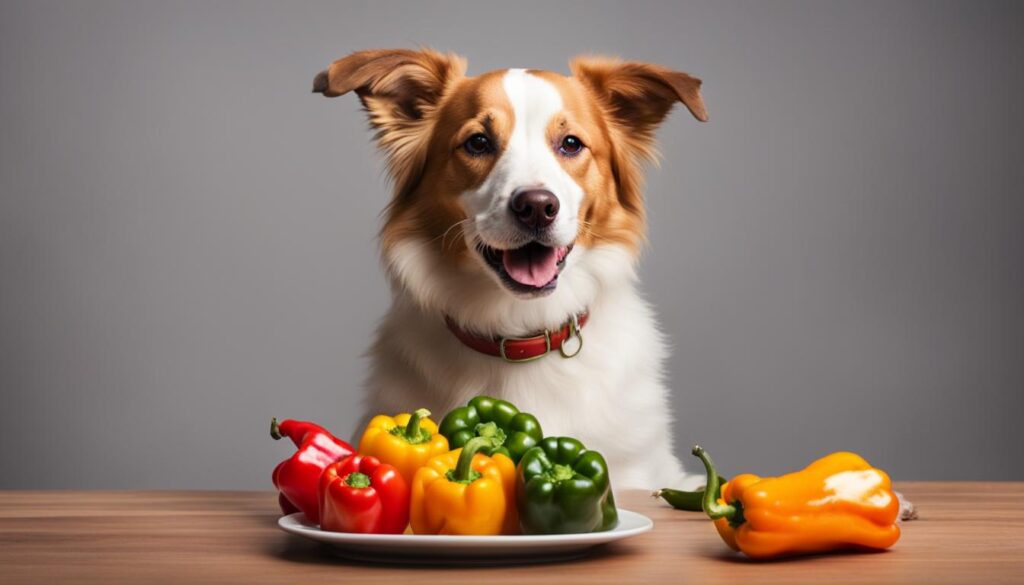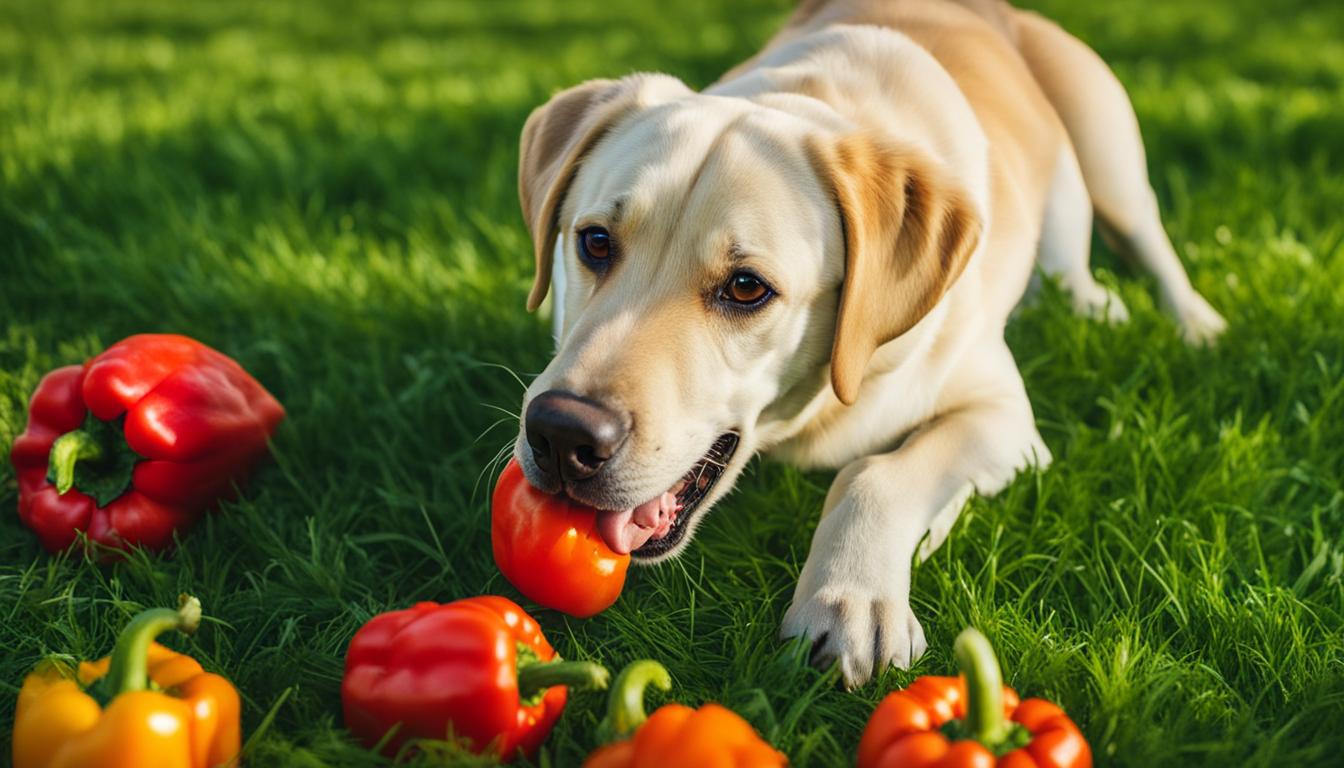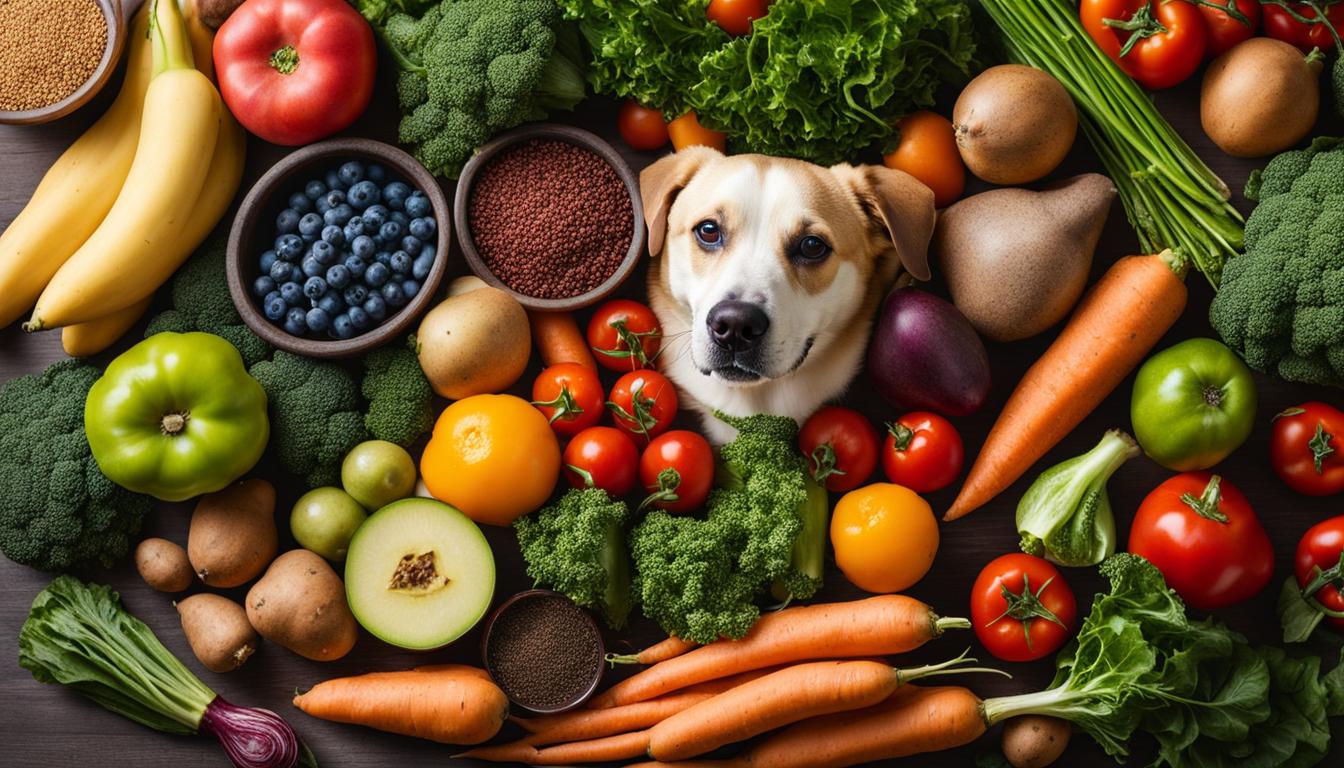Are you wondering if it’s safe to feed peppers to your furry friend? Well, you’re in the right place! In this guide, we’ll explore the world of peppers and their compatibility with dogs. From the dog-friendly varieties to the potential health benefits, we’ve got you covered. So, let’s dive in!
Key Takeaways:
- Bell peppers, including red, green, yellow, and orange varieties, are safe for dogs.
- Peppers are packed with essential vitamins and nutrients beneficial for a dog’s immune system.
- It’s important to introduce peppers slowly and in moderation to your dog’s diet.
- Remove the seeds and stems, and avoid adding seasonings, salt, onions, and garlic to the peppers.
- Spicy pepper varieties, like jalapeños, should be avoided as they can cause discomfort and gastrointestinal issues.
Health Benefits of Peppers for Dogs
Peppers offer various health benefits for dogs. They are rich in vitamins A, E, B6, and lutein, which are important for a dog’s skin, coat, eye health, and immune system. Peppers are also a great source of vitamin C and beta-carotene, which contribute to overall health and well-being. Additionally, peppers are low in calories and can provide hydration due to their high water content.
| Nutrient | Benefits |
|---|---|
| Vitamins A, E, B6, Lutein | Supports skin, coat, eye health, and immune system |
| Vitamin C, Beta-Carotene | Contributes to overall health and well-being |
| Low Calories, High Water Content | Helps with hydration and weight management |
However, it’s crucial to feed peppers in moderation and consult with a veterinarian before introducing them to your dog’s diet. While peppers can offer health benefits, every dog is different, and it’s important to consider your dog’s specific nutritional needs and any underlying health conditions.
Green Peppers for Dogs
Green peppers are a dog-friendly pepper variety that can be included in their diet. They contain similar nutritional benefits as other colored peppers, with vitamins A, E, B6, lutein, vitamin C, and beta-carotene. However, it’s essential to ensure that the peppers are fresh and free from any pesticides or harmful chemicals. Wash and remove the seeds and stems before offering them to your furry friend.
“Peppers offer a tasty and nutritious addition to your dog’s diet, but remember to introduce them slowly and in moderation, ensuring they are well-tolerated.”
By incorporating peppers into your dog’s meals occasionally, you can provide them with added vitamins and nutrients. However, it’s important to remember that peppers should not replace a balanced and complete dog food diet. Always consult with your veterinarian to determine the appropriate portion size and frequency of feeding peppers to your dog.

Safe Pepper Varieties for Dogs
When it comes to feeding peppers to your furry friend, it’s essential to know which varieties are safe and which should be avoided. Dogs can safely eat bell peppers of any color, including red, yellow, green, and orange. These sweet pepper varieties offer numerous health benefits and can be a nutritious addition to your dog’s diet.

Red bell peppers, in particular, have the highest nutritional value among the different colors. They are rich in essential vitamins and antioxidants that promote a dog’s overall well-being. However, it’s crucial to remove the seeds and stems before offering them to your four-legged companion.
“When feeding your dog bell peppers, it’s important to stick to the sweet varieties and avoid the spicy ones,” advises Dr. Sarah Johnson, a veterinarian specializing in canine nutrition.
“Spicy peppers like chili peppers, jalapenos, and habaneros contain capsaicin, which can cause irritation and gastrointestinal issues in dogs.”
They should never be fed to dogs.
| Safe Pepper Varieties for Dogs | Nutritional Benefits |
|---|---|
| Red Bell Peppers | High in vitamins A, E, B6, and lutein |
| Yellow Bell Peppers | Rich in vitamin C and beta-carotene |
| Green Bell Peppers | Contain vitamins A, E, and B6 |
| Orange Bell Peppers | Good source of vitamins A, E, B6, and beta-carotene |
By incorporating safe pepper varieties into your dog’s diet, you can provide them with essential vitamins and nutrients that contribute to their overall health. Just remember to introduce peppers slowly and in moderation, and always consult with your veterinarian before making any changes to your dog’s diet.
Serving Peppers to Dogs
When it comes to serving peppers to your furry friend, there are a few things to keep in mind. Peppers can be given to dogs both raw and cooked, but it’s essential to avoid adding any seasonings or salt, as these can be harmful to their health. If you choose to cook the peppers, make sure to do so without using oil or any toxic ingredients like onions or garlic. Steaming or lightly cooking the peppers can make them easier for your dog to chew and digest.
The outer skin of a bell pepper can be tough, so consider pureeing or chopping the peppers into smaller pieces for easier consumption. If you’re unsure about how your dog will react to peppers, it’s always best to consult with your veterinarian before introducing them into their diet. They can provide you with specific recommendations based on your dog’s individual needs.
Remember, every dog is different, and what works for one may not work for another. Monitoring your dog’s response to peppers and making adjustments accordingly is crucial. Always prioritize their safety and well-being when incorporating new foods into their diet.

| Raw Peppers | Cooked Peppers | |
|---|---|---|
| Nutritional Value | High | High |
| Texture | Crunchy | Softer |
| Digestibility | May be difficult for some dogs | Easier to chew and digest |
| Preparation | Wash and remove seeds/stems | Steam or lightly cook without seasoning |
Moderation and Potential Risks
When it comes to feeding peppers to your furry friend, moderation is key. While bell peppers are generally safe for dogs, it’s important to remember that excessive consumption can lead to an upset stomach, vomiting, and diarrhea. So, it’s best to introduce peppers slowly and in small amounts to gauge your dog’s reaction.
Some dogs may have a sensitivity to peppers, especially if they are fed raw. Raw peppers can be difficult for dogs to digest, so it’s recommended to lightly cook or steam them before serving. This not only makes them easier to chew and digest but also helps to break down their tough outer skin.
Additionally, it’s crucial to remove the seeds and stems from peppers before feeding them to your dog. These parts can pose a choking hazard or cause gastrointestinal distress. Always remember to stick to sweet, non-spicy pepper varieties, as spicy peppers can irritate your dog’s digestive system.
Potential Risks of Spicy Peppers
Spicy varieties of peppers, such as chili peppers, jalapenos, and habaneros, should never be given to dogs. These peppers contain a compound called capsaicin, which can cause discomfort, irritation, and gastrointestinal issues in dogs. Symptoms may include drooling, excessive panting, vomiting, diarrhea, and even internal injuries in severe cases.
If you suspect that your dog has ingested spicy peppers or is showing any signs of distress, it’s important to contact your veterinarian immediately. They will be able to provide proper guidance and treatment if necessary.
| Pepper Variety | Safety for Dogs |
|---|---|
| Bell Peppers (red, green, yellow, orange) | Safe |
| Spicy Peppers (chili, jalapeno, habanero) | Unsafe |
By following these guidelines and consulting with your veterinarian, you can safely incorporate bell peppers into your dog’s diet and provide them with the benefits of vitamins and nutrients without any potential risks.
Conclusion
In conclusion, peppers can be a tasty and nutritious addition to your dog’s diet. They offer essential vitamins and nutrients, while being low in calories. It’s important to choose dog-friendly pepper varieties, such as bell peppers of any color, including red, yellow, green, and orange. These peppers provide important vitamins like A, E, B6, and lutein, which contribute to your dog’s overall health and well-being.
However, it’s crucial to introduce peppers slowly and in moderation to avoid any digestive upset. Remember to remove the seeds and stems before feeding them to your furry friend. Also, avoid spicy or hot pepper varieties, as these can cause discomfort and gastrointestinal distress for your dog.
When serving peppers, you can offer them raw or lightly cooked. Just remember not to add any seasonings or salt, as these can be harmful to dogs. Steaming or lightly cooking the peppers can make them easier for your dog to chew and digest. And if your dog has trouble with the tough outer skin of bell peppers, consider pureeing or chopping them into smaller pieces.
Always consult with your veterinarian before making any changes to your dog’s diet to ensure their specific nutritional needs are being met. By following these guidelines and providing a balanced and well-rounded diet, you can keep your furry friend healthy and happy.
FAQ
Can dogs eat any type of pepper?
Dogs can safely eat bell peppers, including red, green, yellow, and orange varieties. However, spicy pepper varieties such as jalapenos and habaneros should be avoided.
Are bell peppers good for dogs?
Yes, bell peppers are good for dogs. They contain essential vitamins and nutrients, such as vitamins A, E, B6, and lutein, as well as vitamin C and beta-carotene, which are antioxidants important for a dog’s healthy immune system.
Can dogs eat peppers with seeds and stems?
No, it’s important to remove the seeds and stems from peppers before giving them to your dog. These parts can pose a choking hazard and may cause gastrointestinal issues.
Can dogs eat spicy peppers?
No, spicy pepper varieties like jalapenos and habaneros should never be given to dogs. These peppers contain capsaicin, which can cause irritation, discomfort, and gastrointestinal issues in dogs.
Can dogs eat peppers raw?
Yes, dogs can eat peppers both raw and cooked. However, it’s important to remove the seeds and stems and never add seasonings or salt to the peppers.
How should I serve peppers to my dog?
Peppers can be served to dogs raw or cooked. It’s recommended to steam or lightly cook the peppers to make them easier for your dog to chew and digest. You can also puree or chop the peppers into smaller pieces for easier consumption.
How much pepper can I give my dog?
Like with any human food, moderation is key. Start with small amounts and observe how your dog reacts. Excessive consumption can lead to an upset stomach, vomiting, and diarrhea.
Are all types of peppers safe for dogs?
Dogs can safely eat bell peppers of any color, including red, yellow, green, and orange. However, red peppers have the highest nutritional value.
Are there any risks associated with feeding peppers to dogs?
While bell peppers are generally safe, some dogs may have a sensitivity to them and may experience digestive issues. It’s important to monitor your dog’s response and make adjustments accordingly.
Should I consult my veterinarian before feeding peppers to my dog?
Yes, it’s always a good idea to consult with your veterinarian before introducing any new foods into your dog’s diet, including peppers. They can provide guidance based on your dog’s specific nutritional needs.





